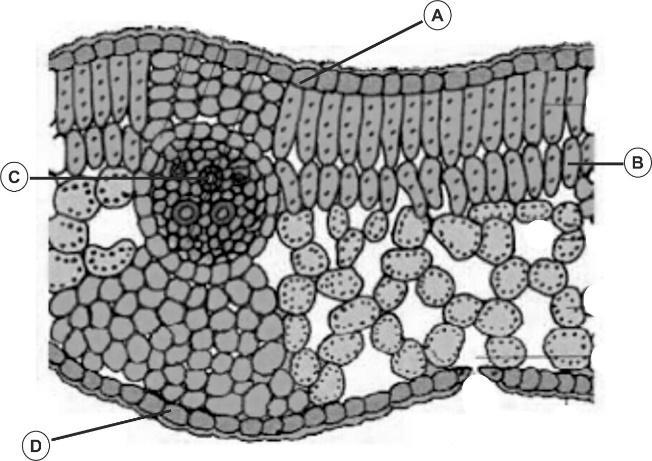
Answer
447.6k+ views
Hint: Monocotyledons commonly mentioned as monocots, are grass and grass like flowering plants, the seeds of which usually contain just one embryonic leaf or cotyledon. They constitute one among the main groups into which the flowering plants have traditionally been divided, the remainder of the flowering plants having two cotyledons and thus classified as dicotyledons or dicot.
Complete answer: The anatomy of isobilateral leaf is similar to that of the dorsiventral leaf in many ways. It shows the following characteristic differences. In an isobilateral leaf, the stomata are present on both the surfaces of the epidermis and the mesophyll is not differentiated into palisade and spongy the stomata are present on both the surfaces of the epidermis and the mesophyll is not differentiated into palisade and spongy parenchyma. In grasses certain adaxial epidermal cells along the veins modify themselves into large, empty, colorless cells. These are called uniform cells, when the uniform cells within the leaves have absorbed water and are turgid, the leaf surface is exposed once they are flaccid thanks to water stress, they create the leaves curl inwards to attenuate water loss. The parallel venation in monocot leaves is reflected within the near similar sizes of vascular bundles (except in main veins) as seen in vertical sections of the leaf.
So, the correct answer is “Option A”.
Note:
The given diagram shows the structure of a monocot leaf. A- it is uniform cells which are present in the upper epidermis which actively participate in motor action. B- Photosynthesis is carried by loosely packed mesophyll cells. C- Vascular bundles help in the conduction of organic materials. D-Transpiration regulated by the guard cell.
Complete answer: The anatomy of isobilateral leaf is similar to that of the dorsiventral leaf in many ways. It shows the following characteristic differences. In an isobilateral leaf, the stomata are present on both the surfaces of the epidermis and the mesophyll is not differentiated into palisade and spongy the stomata are present on both the surfaces of the epidermis and the mesophyll is not differentiated into palisade and spongy parenchyma. In grasses certain adaxial epidermal cells along the veins modify themselves into large, empty, colorless cells. These are called uniform cells, when the uniform cells within the leaves have absorbed water and are turgid, the leaf surface is exposed once they are flaccid thanks to water stress, they create the leaves curl inwards to attenuate water loss. The parallel venation in monocot leaves is reflected within the near similar sizes of vascular bundles (except in main veins) as seen in vertical sections of the leaf.
So, the correct answer is “Option A”.
Note:
The given diagram shows the structure of a monocot leaf. A- it is uniform cells which are present in the upper epidermis which actively participate in motor action. B- Photosynthesis is carried by loosely packed mesophyll cells. C- Vascular bundles help in the conduction of organic materials. D-Transpiration regulated by the guard cell.
Recently Updated Pages
Write the IUPAC name of the given compound class 11 chemistry CBSE

Write the IUPAC name of the given compound class 11 chemistry CBSE

Write the IUPAC name of the given compound class 11 chemistry CBSE

Write the IUPAC name of the given compound class 11 chemistry CBSE

Write the IUPAC name of the given compound class 11 chemistry CBSE

Write the IUPAC name of the given compound class 11 chemistry CBSE

Trending doubts
Fill the blanks with the suitable prepositions 1 The class 9 english CBSE

Which are the Top 10 Largest Countries of the World?

How do you graph the function fx 4x class 9 maths CBSE

Distinguish between the following Ferrous and nonferrous class 9 social science CBSE

The term ISWM refers to A Integrated Solid Waste Machine class 10 social science CBSE

The Equation xxx + 2 is Satisfied when x is Equal to Class 10 Maths

Difference between Prokaryotic cell and Eukaryotic class 11 biology CBSE

Which is the longest day and shortest night in the class 11 sst CBSE

In a democracy the final decisionmaking power rests class 11 social science CBSE





